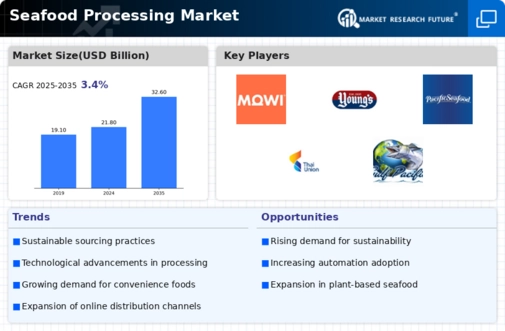Top Industry Leaders in the Seafood Processing Market

The Seafood Processing market is a dynamic and complex industry, integral to meeting the global demand for processed seafood products. This analysis delves into the competitive landscape, featuring key players, their strategies, market share influencers, news on emerging companies, industry trends, investment patterns, and a significant development in 2023.
Key Players:
Pisces Fish Machinery Inc. (US)
Marel (Iceland)
GEA Group (Germany)
Optimar AS (Norway)
Uni-Food Technic A / S (Denmark)
Baader Linco Inc. (US)
The Middleby Corporation (US)
JBT Corporation (US)
Skaginn 3X (Iceland)
Arenco AB (Sweden)
Zhengda Food Machinery Co.,Ltd (China)
KROMA A/S (Denmark)
Seafood Technology Limited (UK)
T.C. Food Equipment, Inc. (US)
SEAC AB (Sweden)
Strategies Adopted:
In a sector where sustainability, quality, and regulatory compliance are paramount, companies in the Seafood Processing market adopt various strategies to maintain and enhance their competitive positions. Diversification of product offerings, including value-added and convenience seafood products, is a common approach. Additionally, strategic alliances with fisheries and aquaculture operations ensure a consistent and sustainable supply chain.
Technological innovation is crucial for maintaining efficiency and product quality. Companies invest in advanced processing technologies to enhance productivity and meet stringent quality standards. Strategic marketing efforts, including certifications such as MSC (Marine Stewardship Council) and ASC (Aquaculture Stewardship Council), contribute to brand differentiation and consumer trust.
Market Share Analysis:
Several factors influence market share within the Seafood Processing market. The ability to ensure a stable and sustainable supply chain of raw seafood materials is fundamental. Key players invest in establishing robust relationships with fisheries, implementing responsible fishing practices, and adhering to stringent quality control measures to secure a consistent supply.
Brand reputation and adherence to food safety regulations are critical determinants of market share. Companies that consistently deliver high-quality and safe seafood products garner trust among consumers and industry stakeholders, contributing to a larger market share. Efficient distribution networks, both domestically and internationally, also play a significant role in market presence.
News & Emerging Companies:
The Seafood Processing market often revolves around sustainability initiatives, technological advancements, and the entry of emerging players. Emerging companies in this sector frequently focus on innovative processing methods, sustainable sourcing practices, and the development of niche seafood products to carve a space in the competitive market.
The industry has witnessed the emergence of smaller, specialized seafood processors, often emphasizing organic and locally sourced seafood. These companies leverage their flexibility to adapt to changing consumer preferences and explore unique market niches.
Industry Trends:
The Seafood Processing market reflect a commitment to sustainability, technology adoption, and market expansion. Investments in eco-friendly and energy-efficient processing technologies align with the growing consumer demand for responsibly sourced and processed seafood.
Vertical integration is a notable trend, with companies investing in aquaculture operations or acquiring fishing vessels to gain more control over the supply chain. This ensures a steady supply of raw materials and enhances the overall efficiency of the processing operations. Additionally, investments in research and development focus on creating innovative seafood products and improving processing methods.
Competitive Scenario:
The Seafood Processing market presents a competitive landscape where established players leverage their global reach and comprehensive supply chains to maintain dominance. However, the market is dynamic, with smaller, innovative companies introducing sustainable practices and unique products. The overall competitive scenario is characterized by a balance between industry giants and agile newcomers, fostering continual growth and innovation within the Seafood Processing market.
Recent Development
The Seafood Processing market was the introduction of a state-of-the-art processing facility by a leading player. This facility was designed to incorporate the latest technologies, ensuring enhanced efficiency, quality control, and sustainability. The investment underscored the company's commitment to meeting the increasing demand for responsibly sourced and processed seafood products.
This development also addressed the growing emphasis on transparency in the seafood supply chain, demonstrating the industry's responsiveness to consumer concerns regarding sustainability and ethical practices. The new facility was positioned to strengthen the company's competitive position by delivering high-quality and traceable seafood products to meet evolving market demands.


